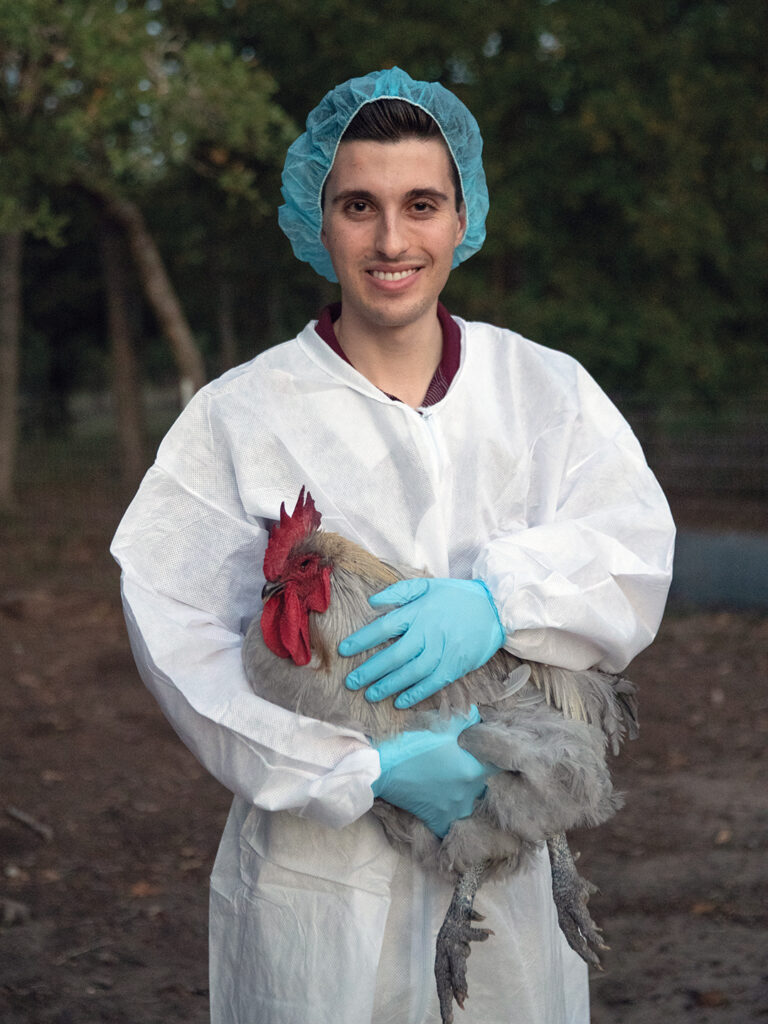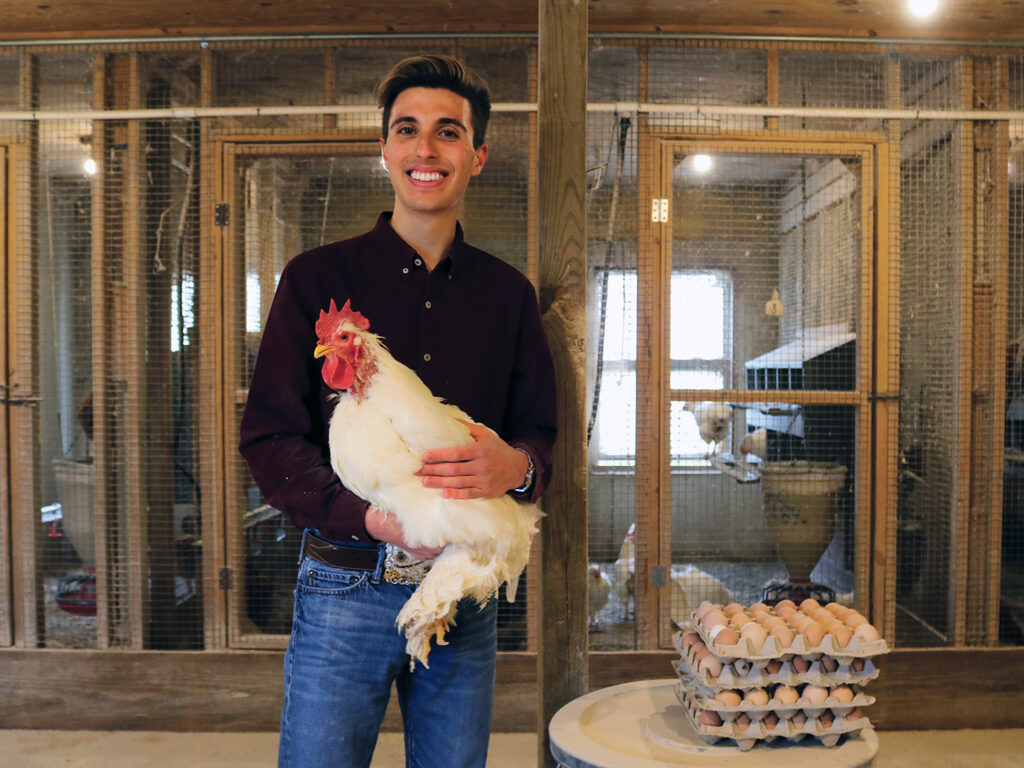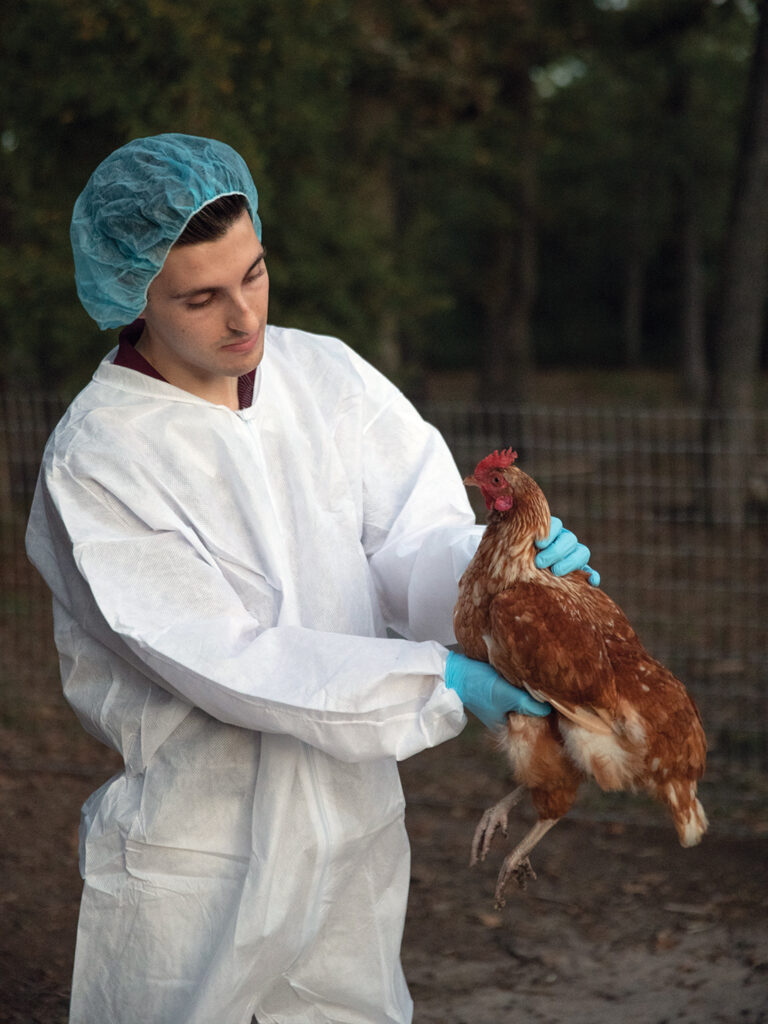Graduating Veterinary Student To Help Fill Nation’s Critical Shortage Of Poultry Veterinarians
Story by Ashley Vargo

According to Texas A&M School of Veterinary Medicine & Biomedical Sciences (VMBS) fourth-year veterinary student Jason Sousa, any part of the veterinary curriculum can be about poultry if you try hard enough.
Growing up around cats and dogs, Sousa knew he was going to be a veterinarian by the time he was 6 years old, but it wasn’t until he got to high school that he developed a passion for poultry.
“I hadn’t had any exposure to poultry before high school,” Sousa said. “Then I raised chickens and turkeys for FFA and did a little bit of everything with poultry.”
In 2015, he began his undergraduate degree in poultry science at Mississippi State University — and loved every minute of it.
“I realized that I could be a poultry veterinarian and that that was a viable career in an area where there was a need,” Sousa said. “I came into veterinary school knowing that that’s what I wanted to do.”
For Sousa, there are many aspects of the field that make poultry medicine appealing, but the interest begins simply with the birds.
“Birds are just very cool,” he said. “Their anatomy, their physiology — it’s all so unique and well-adapted to serve birds’ purposes, whatever they may be.”
After starting his veterinary school journey, though, Sousa discovered just how scarce poultry veterinarians are. Because he estimates that there are only about 300 poultry veterinarians in the United States, whereas small animal veterinary students can find a variety of mentors available for each challenge they face, Sousa had to be a bit more creative with finding mentorships and experiences.
In his sophomore year, Sousa was assigned two mentors — Dr. Brandon Dominguez, at Texas A&M, and Dr. Yuko Sato, a poultry veterinarian at Iowa State University.
“Dr. Sato and I meet on Zoom every semester; she offered to let me come up and spend time with her lab and some poultry vets up in Iowa,” Sousa said. “I see her at all of the conferences I go to. I was so impressed that A&M was willing to go the extra step to help me make those connections.”
To further those connections and find additional field experience, Sousa is always prepared to jump at a chance to have a new poultry-centered adventure — no matter where it takes him.
“I’ve bounced around every corner of the country because the poultry industry is so geographically distinct,” Sousa said. “The South predominantly has broilers; in the North, there are a lot of layers; the West has a little bit of everything; and the Midwest has a lot of turkeys. You have to jump around to get good experiences.”

Sousa plans to become board certified with the American College of Poultry Veterinarians. Before then, he’ll be heading to the University of Georgia to complete a master of avian medicine program and then to California, Alabama, and Nebraska for more learning opportunities.
Because he has found an unexpected range of possibilities as a poultry veterinarian — from the production and clinical medicine side, in which veterinarians go out into the field daily to evaluate birds on farms, to the diagnostic and research side — his long-term goals remain up in the air, but he knows that no matter where he ends up in the industry, the work will be fascinating.
“I don’t know what that’s going to look like quite yet because I like it all a little too much to say I’m only going to work with one particular type of poultry for the rest of my life,” Sousa said.
One of his favorite aspects of the poultry industry is that it is vertically integrated, which means that many of the companies involved own everything from the hatchery and feed mill to the birds themselves, as well as the processing plants. As such, many of the consultations Sousa has participated in require plenty of detective work and investigative prowess.
“As a poultry veterinarian, if a plant says, ‘We’re noticing this problem; what’s going on?’ I might end up tracing that all the way back to the feed mill where they miscalculated the calcium and phosphorus inclusion,” he said. “I like that poultry vets get to have their toe in every single area of production and get to investigate what’s happening.”
In addition to the tracebacks, Sousa has found that the work requires a lot of forward thinking at an industrial scale.
“With clinical medicine, you might be looking at 100,000 birds or more at any given time,” he said. “You have to say, ‘How do I treat them?’ but, also, ‘How do I prevent this from happening the next time we place a flock in this house?’ You get to develop biosecurity and vaccine protocols.”
Along with keeping the birds healthy, part of a poultry veterinarian’s job is to keep in mind the safety of the people whom the animals will feed. With poultry constituting such a large part of the American diet, the field has become deeply intertwined with both public health and epidemiology.

In the future, Sousa believes that the path toward increased food safety will involve more collaboration between poultry scientists, researchers, and veterinarians.
“Food safety is absolutely something that’s coming under more and more scrutiny,” Sousa said. “It’s important that there’s collaboration. I think it’s at the forefront of everybody’s minds because there’s still a lot that we don’t know about what we, as veterinarians, can do, especially in the midst of growing pressure to use fewer antibiotics.”
Additionally, the field of poultry medicine must grow in tandem with the ever-expanding human population.
“Poultry production is growing in and of itself, and more chicken houses are being built every year,” Sousa said. “So, the need for poultry veterinarians is definitely getting higher and higher because, on top of the growing industry, older veterinarians are retiring and leaving the industry. I’d say, at this time, there’s probably more of a need for poultry vets than there is a supply of poultry vets.”
Nonetheless, Sousa is happy to be a part of the tight-knit field, and no matter how the specifics of his career shake out, he takes comfort in knowing that he’ll be part of the force for creating positive changes in the availability and safety of human food.
“What really keeps me going about poultry, in particular, is that the world’s population is growing, and the need for a cheap source of protein grows with it,” Sousa said. “Unfortunately, beef and swine take a long time to grow. They’re more expensive and they’re not as accessible to people who need food at a low cost. I think poultry is what’s going to be feeding people in the future.
“What keeps me going, even on bad days, is knowing that what I’m doing is ultimately helping to make sure more birds stay alive and can be a source of food for somebody.”
###
Note: This story originally appeared in the Winter 2023 edition of VMBS Today.
For more information about the Texas A&M College of Veterinary Medicine & Biomedical Sciences, please visit our website at vetmed.tamu.edu or join us on Facebook, Instagram, and Twitter.
Contact Information: Jennifer Gauntt, Director of VMBS Communications, Texas A&M College of Veterinary Medicine & Biomedical Sciences; jgauntt@cvm.tamu.edu; 979-862-4216


